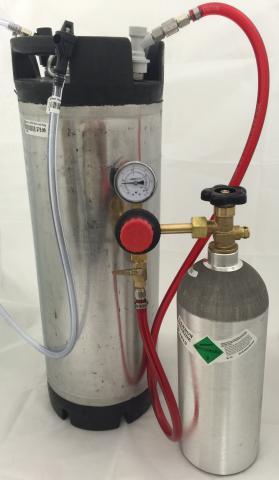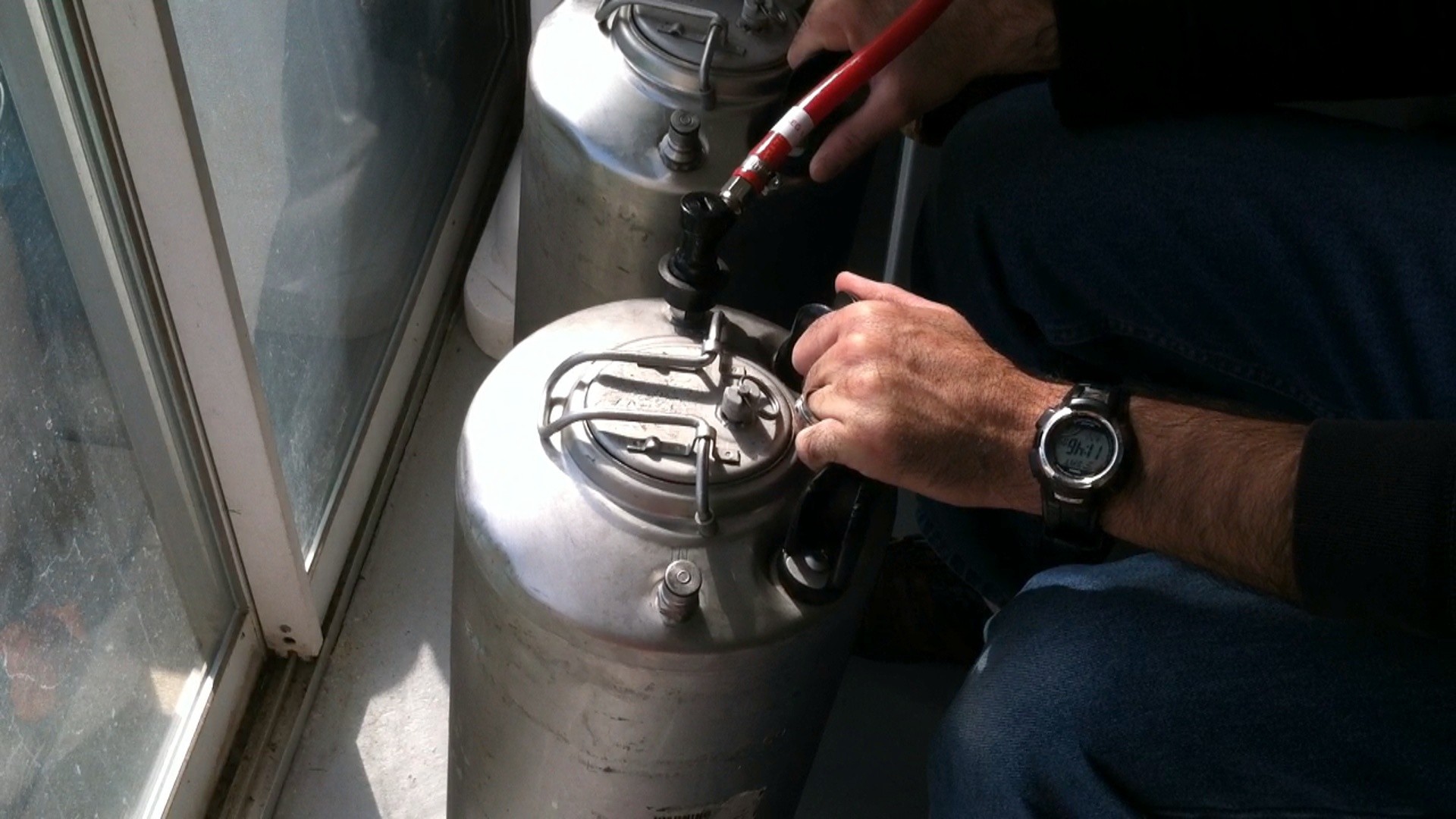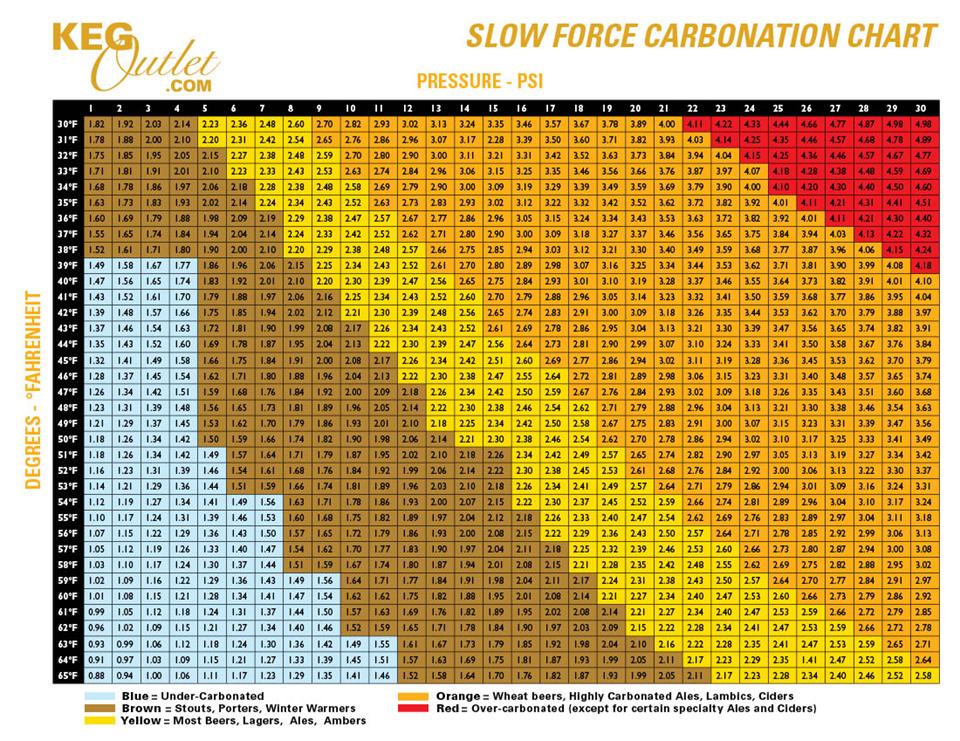Carbonate Keg Overnight
Just the other day I witnessed a guy take a batch that had been cold-crashed racked it to the keg agitated and served properly carbonated beer in 30 minutes we had an issue with racking so took a bit longer. Alternatively leave the CO2 connected now for 5 days to fully carbonate the beer and then disconnect.
Download the Keg Carbonation Chart and save it in your reference library.

Carbonate keg overnight. The key is agitation. Guide to a Properly Carbonated Beer Keg. There are two main approaches you can take to cool your wort overnight in a more natural way either by leaving it in your brew kettle or by racking it.
Question is after reading the above can I fill the keg purge at 30psi then store warm for 1-3weeks when ready to drink put in fridge at 12psi for a week or two. Experiment with settings to. Just sit there and roll it on the floor with your feet for 45 minutes or so you can count this as exercise and reward yourself with beer take it down to serving and pour a bit.
I usually force carb my kegs at 25PSI overnight approximately 24 hours then drop it down to 10-12PSI. To burst carbonate your homebrew crank up your CO2 regulator to 30 psi for 24 hours. So I made the decision to not dry hop my IPA that had finished fermenting and force carbonate it overnight Friday to serve on Saturday.
NEVER use chlorine bleach on your keg because chlorine bleach can pit. If it still likes some carbonation leave it at 30 overnight and check it in the morning. Shake up the keg to get some of the solution on all of the interior surfaces.
This method works fast because the stone breaks the CO2 up and injects tiny bubbles with huge amounts of surface area directly into your beer. Set the PSI all the way up to 25-35 psi lay the keg on its side and rollshake the keg for about 5-8 minutes. Boil your stone for a few minutes before use.
How do you force carbonate beer overnight. Remember to burp the keg and. Always let your keg sit overnight before tapping to allow it to reach serving temperature.
I had hoped to have my local brewery fill a 5 gallon corny keg on Friday for a big party we were throwing on Saturday but alas they were too busy to do it. While an unbalanced keg may pour just fine initially it may lead to over-carbonation or undercarbonation by the end of the keg. For really stubborn stains an overnight soak is even better.
CO2 absorbs better when cold 34 - 40F. Results will vary depending on beer styles. Ive seen this occur myself.
Set the CO2 pressure using our favorite carbonation table THEN shake the keg until you dont hear any more gas being accepted listen to the regulator. Its not as accurate as the slower method but it will carbonate your beer much faster. When your beer has finished fermenting its time to carbonate.
Once your solution is in the keg use your sanitized siphon to rack your beer from the fermenter to the keg. It will carbonate a five gallon keg overnight. It shaves off a couple of days by doing the initial carbonation but doesnt risk adding too much.
Current fridge wont hold 4 x 10l kegs. Cold beer absorbs CO2 better than warm beer. Keep shaking the keg for 20 to 30 minutes lower the pressure relief valve to 20 psi and allow the keg to carbonate for 2 to 3 days.
Take it up to 30 and shake the crap out of it for a while. If You Vigorously Roll. Make sure you follow proper sanitation techniques as always.
Using this method you can chill your keg overnight bump the pressure up before work in the morning. Currently I brew the beer in Beerdroid then into keg as per ikegger instructions into fridge at 12 psi for a week or two then drink. In short to rapid carbonate a beer all you have to do is put the beer under pressure thats 2-25X higher than your intended serving pressure at cold temps and shake until done.
Here is a quick industry tr. At this point youll need to make food sugar water for the yeast. The absorption rate is very slow when warm but the solvent will take the CO2 overnight if the keg is left in ice and chilled.
So plan for at least overnight or the better part of a day to get the beer as cold as your serving temp at least. Vigorously roll it for about 4 minutes only stopping to listen and check how fast the bubbles stop flowing. This approach tends to be less likely to over-carbonate your beer unless you forget about it.
Move the lid from keg to keg to carbonate as needed. My mother-in-law a long time homebrewer knows that under forced carbonation in a keg beer will carbonate faster cold than if you carbonate it at room temperature. You can go from uncarbonated in the fermenter to carbonated in the keg in about 15 minutes.
The quicker you hear the bubbles the further you are into the carbonation process. For example You may want to do the burst carbonation overnight while you sleep and then reduce the pressure in the morning. This is a Cornelius keg lid with built-in carbonation stone.
Depending on when you will be able to check in on the beer you may want to alter the pressure you use to burst carbonate. Start by setting the regulator to 8 PSI. This ends up being the best of both worlds.
But I am having a time with my first kegged beer. Temperature and pressure are the two factors involved in making sure the keg always has the proper amount of CO2 in solution. Let it sit for 30 minutes then do the same thing again.
Be sure to let the beer settle for a few hours overnight is best so youre not pouring all foam. To force carbonate the new beer first decide how much carbonation you want. Instead of making a blanket on top of it like the set and forget method.
You can prime in the keg and wait the required two to three weeks or try force carbonating your beer in just a few minutes. Let the keg set for about 30 minutes for the cleaner to do its work. Allows you to force carbonate quickly using the attached 5 micron stone with the portability of being able to move the lid from keg to keg.
Carbonation stones are porous. The beer will stay carbonated and will be ready when you need it. The easiest way to carbonate beer.
Most beer will carbonate overnight. Once its carbonated set the regulator back to. What PSI should a keg be.
It will carbonate a five gallon keg overnight. During serving its a good idea to keep the CO2 connected if much of the keg will be consumed so the dispensing pressure is maintained. What PSI should I force carbonate beer.

How To Force Beer Carbonation Midwest Supplies

Amazon Com Perlick Wrap Around Draft Beer Faucet Lock Home Kitchen Brewing Supplies Best Kitchen Faucets Beer Brewing Supplies

Pin On Infographics Helpful How To S

Marvel Kegerator Dispenser X Clusive Stainless Check Out This Great Product This Is An Affiliate Link Beerke Kegerator Cabinet Beer Dispenser Kegerator

Taprite 43 0153 Ball Lock Coupler Mfl Home Brew Set Seamlessly Switch Between Kegs And Lines With The Ball Lock Coupler Mfl H In 2020 Home Brewing Brewing Home Brewery

How To Carbonate Beer In A Keg Kegking Blog

Force Carbonation In Keg Instructions

Corny Keg Carbonating Instructions Bader Beer Wine Supply
Quck Carb How To Carbonate A Keg In 30 Minutes Clawhammer Supply

How To Carbonate Beer In A Keg Kegking Blog

Homebrew Finds Reader Tip 2 Micron Carbonation Aeration Stone 5 99 Free Shipping Beer Brewing Supplies Wine Making Supplies Beer Brewing System

Quick And Easy Keg Force Carbonation



Posting Komentar untuk "Carbonate Keg Overnight"